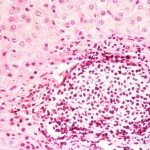Link to Pubmed [PMID] – 19331731
Emerging Infect. Dis. 2009 Apr;15(4):552-60
In Europe, the 2007-08 winter season was dominated by influenza virus A (H1N1) circulation through week 7, followed by influenza B virus from week 8 onward. Oseltamivir-resistant influenza viruses A (H1N1) (ORVs) with H275Y mutation in the neuraminidase emerged independently of drug use. By country, the proportion of ORVs ranged from 0% to 68%, with the highest proportion in Norway. The average weighted prevalence of ORVs across Europe increased gradually over time, from near 0 in week 40 of 2007 to 56% in week 19 of 2008 (mean 20%). Neuraminidase genes of ORVs possessing the H275Y substitution formed a homogeneous subgroup closely related to, but distinguishable from, those of oseltamivir-sensitive influenza viruses A (H1N1). Minor variants of ORVs emerged independently, indicating multiclonal ORVs. Overall, the clinical effect of ORVs in Europe, measured by influenza-like illness or acute respiratory infection, was unremarkable and consistent with normal seasonal activity.

